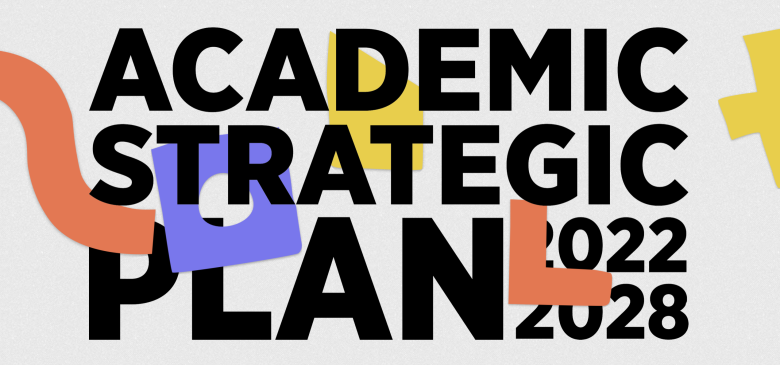
OCAD University has launched its new six-year Academic and Strategic Plan that charts the course for Canada’s leading art and design university to further drive impact and innovation in teaching, learning and scholarship.
The plan presents the new vision—OCAD U is a vibrant community of bold, curious and compassionate artists, designers and scholars imagining and creating a joyful, equitable and sustainable world—that is about transforming people’s lives. The plan also presents a new mission statement as well as seven interconnected priorities with corresponding big picture objectives.
“As the world continues to undergo an unprecedented series of economic, social, environmental, technological transformations, our new vision sets our intention to facilitate and nurture the growth and success of our students so they can adapt and flourish,” says OCAD U President and Vice-Chancellor Ana Serrano.
She noted that the University’s application of art and design thinking and methods across the various fields of science, health, technological invention, history, strategic foresight, philosophy, and curatorial studies is what makes OCAD U a unique institution of study for students preparing themselves for careers in a society in flux.
“The times we live in demand nimble and critical thinking,” says Serrano. “Our interdisciplinary approach to learning, with increased opportunities for students to add breadth to their knowledge, will amplify the versatility of their degrees and ability to respond to the big questions of the 21st century.”
The plan’s seven interrelated priorities speak to the University’s commitment to providing enriching and engaging learning experiences for its students as it drives positive impact as a local, regional and global leader in art and design:
- Drive Positive Impact
- Pursue Environmental Sustainability
- Innovate Learning, Teaching and Research
- Centre the Student Journey
- Decolonize and Indigenize Art and Design Education and Advance Equity
- Emerge as a Vibrant Hub
- Steward Financial Health
Developing the integrated plan was a year-long co-creation process that drew upon the previous Academic Plan, 2017-22, which focused on decolonization and the prioritization of Indigenous Learning: Nothing About Us Without Us. The guiding principles articulated in the 2017-22 plan—decolonization diversity and equity, sustainability, valuing faculty, interdisciplinarity, and health and wellness—were part of the thinking as the University developed its new integrated plan.
“The past five years have been transformational for OCAD University. We have made significant impacts under the previous Academic Plan’s guiding principles and as result, the University has transformed into a leader in diversity for higher education,” says OCAD U Vice-President, Academic and Provost Dr. Caroline Langill.
For example, due to a rigorous approach to hiring, the University has made steady progress in ensuring that faculty members reflect the breadth of identities of OCAD U students. The new plan’s priority, Decolonize and Indigenize Art and Design Education and Advance Equity, will continue the work of decolonization and equity to redress under-representation of Indigenous, Black and racialized faculty and staff to better reflect the diversity of our students.
The University’s pandemic-led pivot to online and flexible learning modes resulted in significant innovations in the delivery of art and design education. Under the plan’s priority, Innovate Learning, Teaching and Research, OCAD U will continue to improve learning spaces and outcomes through exchange, innovation and experimentation.
Dr. Langill points to the transformation of program curriculum that now includes global histories and cultures.
“We are so grateful for the Indigenous Elders and Knowledge Keepers who guided us through the process to develop a Wholistic approach to our curriculum, and they will continue to provide us with guidance to integrate Indigenous Knowledge into course content,” she says.
The priority, Centre the Student Journey, focuses on how the University can cultivate the personal and professional growth of its students, and create an inclusive learning environment that promotes creativity, curiosity and critical thinking.
“We will be looking at how we can improve the accessibility and flexibility of art and design education, teaching and research with a focus on Indigenous, racialized and multilingual students,” says Dr. Langill. “We will also be looking expand and improve access to student mental health supports and increase funding opportunities and financial support, especially for our international students.”
The plan also reflects the University’s commitment advancing responsible environmental practices and promoting sustainability through its academic and administrative programs. One such initiative is the creation of a new Global Centre for Climate Action that will facilitate a global network for research and creative practice and engage with the public through critical dialogues on climate resilience from the lens of art and design.
“We will work collaboratively to demonstrate how advances in art and design can intersect with other fields to mitigate the climate crisis, as well as other societal needs. Research will play a key component in this work and our work to emerge as a vibrant hub, another one of our seven priorities,” says Serrano.
The plan also identifies the priority to steward financial health, which will continue the work to move the University towards long-term financial sustainability.